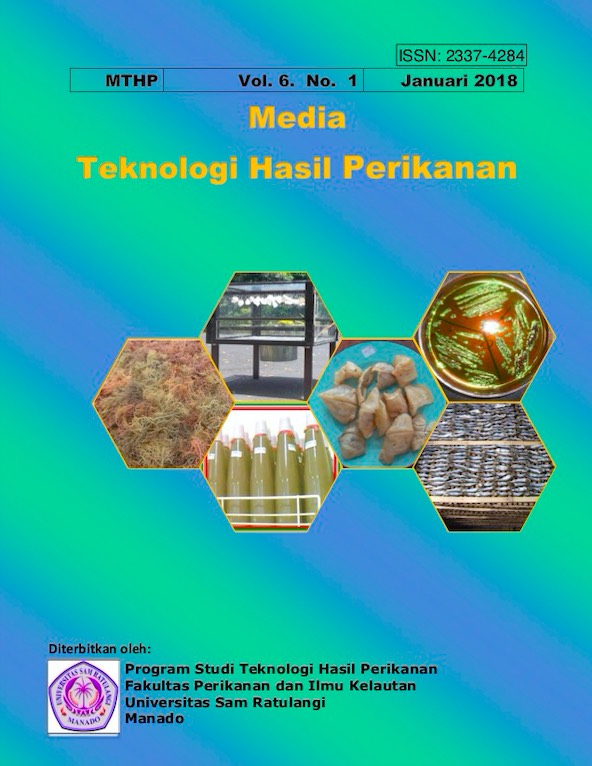KADAR AIR, pH, DAN KAPANG IKAN CAKALANG (Katsuwonus pelamis L.) ASAP CAIR YANG DIKEMAS VAKUM DAN NON VAKUM PADA PENYIMPANAN DINGIN
DOI:
https://doi.org/10.35800/mthp.6.1.2018.16851Keywords:
Water content, pH and Kapok Tailed Fish Fish (Katsuwonus Pelamis) Liquid Packed Vacuum and Non Vacuum On Cold StorageAbstract
Smoking fish with smoke liquid is a method of processing or preserving fish by utilizing a combination of drying treatment with oven and providing natural chemical compounds of liquid smoke. Vacuum packages could be applied to maintain the shelf life of smoked skipjack tuna (Katsuwonus pelamis L.). The main principle of vacuum packaging is to release oxygen (O2) from the product. The combinations with cold storage can be applied to vacuum packaged products so that it may prolong the shelf life. This study aims to observe the deterioration of smoked skipjack tuna quality stored for 0, 7 and 21 days at cold temperatures (± 5ºC), with 2 different packaging style (i.e. vacuum and non-vacuum) The analysis included pH, moisture content and total mold. Also, commercial smoked skipjack tuna, which is processed using conventional smoking process, were used as a comparison in this study. The results showed that the highest moisture content 58.8% was obtained in a sample treated with liquid smoke and vacuum packed, but the lowest moisture content 57% was found in a sample processed with liquid smoke without vacuum package. The highest pH value was 5,885 on the conventional smoked skipjack tuna and the lowest was 5.77 in the vacuum packed samples. The highest total mold value was 3.9x103 colonies in a vacuum packed sample, but the lowest was less than 10 found in a conventional smoked skipjack product.
Â
Pengasapan ikan dengan asap cair merupakan cara pengolahan atau pengawetan dengan memanfaatkan kombinasi perlakuan pengeringan dengan oven dan pemberian senyawa kimia alami asap cair. Salah satu cara yang dapat diplikasikan untuk mempertahankan daya awet ikan cakalang asap (Katsuwonus pelamis L.) yaitu dengan dikemas vakum. Prinsip utama dari pengemasan vakum adalah pengeluaran oksigen (O2) dari produk. Kombinasi dengan penyimpanan dingin dapat diterapkan pada produk yang dikemas vakum untuk mendapat masa simpan yang lebih panjang. Penelitian ini bertujuan untuk mengamati kemunduran mutu ikan cakalang asap yang disimpan selama 0, 7 dan 21 hari pada suhu dingin (±5ºC), yang dikemas vakum dan non vakum. Pengujian mutu meliputi pH, kadar air dan total kapang. Ikan cakalang yang diasap secara konvensional juga dibandingkan dengan sampel ikan asap cair pada penelitian ini. Hasil penelitian menunjukkan bahwa nilai kadar air tertinggi diperoleh pada ikan cakalang asap cair yang dikemas vakum (58,8%) dan terendah (57%) ada pada ikan cakalang asap cair yang tidak dikemas vakum. Nilai pH tertinggi 5,885 pada ikan cakalang asap konvensional dan terendah 5,77 pada ikan cakalang asap cair yang dikemas vakum. Nilai total koloni kapang tertinggi diperoleh pada ikan cakalang asap cair yang dikemas vakum yaitu 3,9x103 koloni dan terendah dengan koloni kurang dari 10 ada pada ikan cakalang yang diasap secara konvensional.
Downloads
Published
How to Cite
Issue
Section
License
Authors who publish with this journal agree to the following terms:
- Authors retain copyright and grant the journal right of first publication with the work simultaneously licensed under a Creative Commons Attribution License that allows others to share the work with an acknowledgement of the work's authorship and initial publication in this journal.
- Authors are able to enter into separate, additional contractual arrangements for the non-exclusive distribution of the journal's published version of the work (e.g., post it to an institutional repository or publish it in a book), with an acknowledgement of its initial publication in this journal.
- Authors are permitted and encouraged to post their work online (e.g., in institutional repositories or on their website) prior to and during the submission process, as it can lead to productive exchanges, as well as earlier and greater citation of published work (See The Effect of Open Access).







